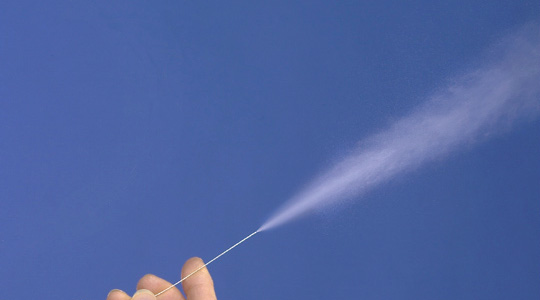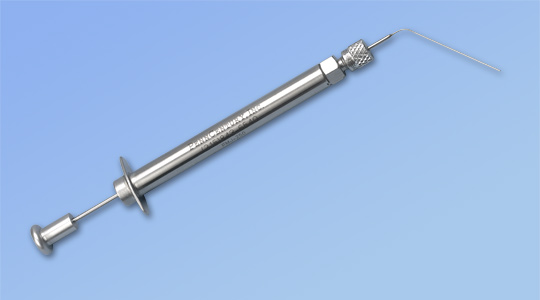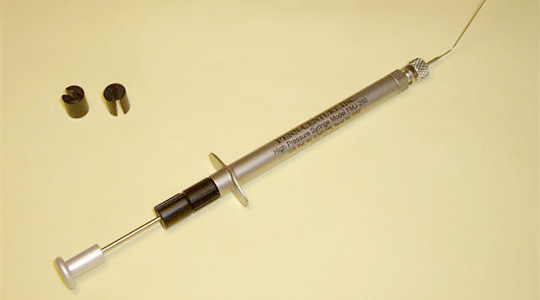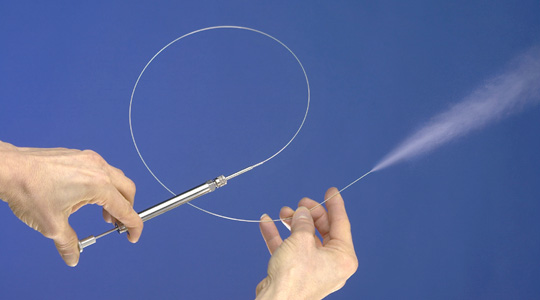
Model Number:
MSA-250-C
All Penn-Century aerosol drug delivery devices are available in custom lengths, made to order for intratracheal or intranasal, in vivo or ex vivo applications, or in vitro experimental laboratory set-ups. Examples include custom-length devices for: rabbits, ferrets, dogs, cats, chickens, pigs, sheep, monkeys, horses, etc. For custom uses, the device can be made to any length – either straight or with a standard 120-degree bend.
For optimal aerosol deposition in the lung, the tip of the MicroSprayer® Aerosolizer Model IA-1C-C may be gently inserted down the trachea of the anesthetized animal, either directly, in small animals, or via an endotracheal tube or bronchoscope in larger animals. The tip of the device must reach to a point above the carina (first bifurcation). MicroSprayer® Aerosolizer – Model IA-1C operates only with Penn-Century’s patented, gas-tight FMJ-250-High Pressure Syringe. This syringe has a maximum capacity of 250 microliters. For larger doses, the syringe can be detached and refilled, or multiple syringes can be prepared in advance.
- To assure that we have sufficient information to provide you with a device that will best suit your need, please complete and submit the Custom Device Questionnaire. Please consider this information carefully, and ask questions if you need guidance, as these devices are manufactured for you specifically. You will be required to confirm your final measurement prior to ordering. NOTE: Once production begins, custom orders cannot be changed, and custom length devices cannot be returned or exchanged.
- For a better understanding of how to determine measurements for a custom length Model IA-1C, see the ‘Diagram’ tab above or download: Guide to Measuring a Custom-length MicroSprayer – Model IA-1C
- For planning for use of a custom length Model IA-1C, see: Instructions for use of Penn-Century MicroSprayer®/Syringe Assembly – MSA-250
The MicroSprayer®/Syringe Assembly – MSA-250-C for Custom Lengths consists of the MicroSprayer® Aerosolizer – Model IA-1C-C and the FMJ-250 High Pressure Syringe, which is required for use of the Model IA-1C devices. The MicroSprayer® Aerosolizer – Model IA-1C-C can be made to any length – with a bend or straight. It is designed for fast, targeted intratracheal aerosol administration to a larger animal – via an endotracheal tube or a bronchoscope. It also can be made to order for other custom or in vitro applications. The device can be used to administer a precisely quantifiable, highly-concentrated, air-free plume of liquid aerosol directly into the lungs or other locations. It can aerosolize a wide range of liquids or particle solutions/suspensions, including pharmaceutical and biologic formulations, contrast/imaging agents and toxicological materials. (It does not administer dry powders.)
For intrapulmonary applications, the tip of the device is gently inserted down the trachea of the anesthetized animal – near to, but not touching the carina (first bifurcation). Larger doses can be administered by refilling and reattaching the FMJ-250 High Pressure Syringe as many times as needed.
- Quick, precise aerosol dosing directly to the lungs – with no waste
- Purely mechanical, air-free technology
- Uses no heat, propellant, ultrasound or compressed air. No air burden to subject.
- Unique patented design is light, hand-held, easy to use
- Rounded tip permits safe, gentle intratracheal insertion
- Fully sterilizable, autoclavable and reusable
- Delivers a far higher volume and concentration than is possible with nebulizer/inhalation systems
- Produces a far broader, more uniform distribution than liquid bolus/droplet instillation methods
MicroSprayer® Aerosolizer – Model IA-1C-C
- Materials: Based on flexible, 23-gauge stainless steel tubing and other chemically resistant components
- Length of intratracheal portion: To be determined by user
- Straight or with 120-degree bend: Custom devices made are available on request either straight or with a 120-degree bend
- Tip is rounded to avoid harm to delicate tissues during insertion.
- Dose range: When used with FMJ-250 High Pressure Syringe, can administer dose volumes up to 250 microliters, or multiple smaller doses of 25 to 50 microliters or combinations of those dose volumes, using dosing spacers provided.
- Outer diameter: .025″ (0.64 mm), except at the very tip which is .028″ (0.71mm)
- Inner diameter: .017″ (0.43 mm) (NOTE: Liquid passes through patented aerosol components at the very tip. The diameter of these passageways in the Model IA-1C is approximately 60 microns in diameter. )
- Re-usable/Sterilizable: Can be cleaned and sterilized with very hot (filtered or distilled) water, organic solvents, by autoclave or ultrasound.
FMJ-250 High-Pressure Syringe
Required for use with MicroSprayer® Aerosolizer – Model IA-1C
- Description: Unique patented air-free, gas tight syringe
- Pressure: Operates at up to 3000 psi.
- Hub: 1/4-28 tpi (Note: Not a luer hub)
- Materials: Constructed of stainless steel and chemically-resistant components with a replaceable plunger with a Teflon® tip. May be used with any length Model IA-1C.
- Maximum Capacity: 250 µl (microliters).
- Dose increments: Two sets of volume spacers are provided with each syringe. These are attached to the plunger, and removed one by one, per instructions provided, to permit precise single doses of either 25-µl or 50-µl, or combinations of those amounts. Syringe holds multiple doses.
- Re-usable/Sterilizable: Can be cleaned and sterilized with hot water, organic solvents, or by autoclave or ultrasound.
When analyzed with water, using Penn-Century’s FMJ-250 High Pressure Syringe, the MicroSprayer® Aerosolizer – Model IA-1C produced a particle size distribution with a Mass Median Diameter (MMD) of 16-22 µm (microns) – when analyzed by laser defraction. NOTE: Results may vary, depending upon method of particle size analysis used, the material delivered and the length of the MicroSprayer® Aerosolizer.
The following devices may be helpful when working with a custom length MicroSprayer® Aerosolizer – Model MSA-250:
- Small Animal Laryngoscope – Model LS-2-C for Larger Species
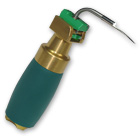
Model Number: LS-2-C Instructions for use Description Specifications Diagram User Info Penn-Century’s Small Animal Laryngoscope Model LS-2-C is specifically designed for custom applications in laboratory animals larger than mouse, rat or guinea pig – such as rabbit, ferret or small primates. (Please contact us to discuss your requirements.) The device provides bright, clear illumination for… Continue reading
- Small Animal Laryngoscope – Model LS-2-C for Larger Species
- Reverse Cleaning Adapter – RCA-1C
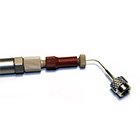
Model Number: RCA-1C Description User Info A new tool to clear blockages in the tip of your MicroSprayer® Aerosolizer Model IA-1C. The Penn-Century MicroSprayer® Aerosolizer – Model IA-1C is a unique, air-free atomizer. It generates an aerosol when liquids, solutions or particle suspensions are pushed at high manual pressure through tiny patented aerosolizing components in… Continue reading
$75.00
- Reverse Cleaning Adapter – RCA-1C
All Penn-Century aerosol drug delivery devices are available in custom lengths for intratracheal or other uses in larger species, in other locations of the body, or in in-vitro, ex-vivo, or other experimental laboratory set-ups. The intratracheal portion (Length A) may be straight, or have a bend. For optimal intratracheal aerosol deposition in the lung and to avoid injury to the animal, the device must be measured correctly to assure that the portion inserted into the trachea is long enough to reach near to but not touching the carina (first bifurcation). In larger animals it may also be possible to insert the device in one lung, if desired. It is the responsibility of the user to determine the correct measurement for their particular use.
For custom devices, the length “A” must be specified, as shown:

NOTE: Thicker “stem” portion is not inserted into the trachea, endotracheal tube or bronchoscope.
Dimensions (approx.)
| A | B | C |
|---|---|---|
| ?? | 120° | 0.5″ |
Key:
Length “A”: Functional length, from bend to tip
Angle “B”: Angle of bend
Length “C”: Length from hub to bend
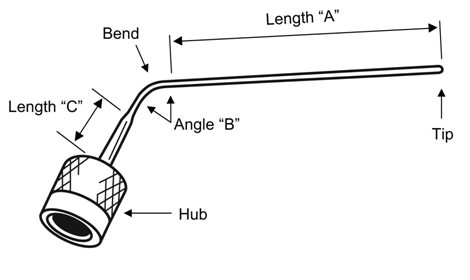
For intratracheal applications in small animals, the MicroSprayer® Aerosolizer Model IA-1C is usually inserted directly into the trachea. The intratracheal portion of the Model IA-1C is designed to reach from the front incisors to the carina or beyond, depending upon the size of the animal used and method of insertion. NOTE: In larger animals users must insert the device via an endotracheal tube or bronchoscope. The device must be measured carefully to accommodate the method of insertion:
- If the Model IA-1C is inserted into the trachea via an endotracheal tube or bronchoscope, the distal tip must emerge slightly (approximately 1 cm) from the end of the endotracheal tube when it is in position. This will assure that the aerosol can freely pass beyond the first bifurcation into the lungs, or into an individual lung.
- The Model IA-1C is flexible, but should never be bent or forced into a sharp angle, or it will be damaged beyond repair.
- When measuring a custom length device via an endotracheal tube or bronchoscope, the user must take into account that some portion of the MicroSprayer® Aerosolizer will retract slightly into the endotracheal tube or bronchoscope when it is manipulated. Therefore, an additional amount of length must be added to compensate for this.
- To avoid injury to the animal, the distal tip of endotracheal tube and the distal tip of MicroSprayer® Aerosolizer should NEVER make contact with the carina when the plunger of the syringe is pushed.
- You will be required to confirm your final measurement prior to ordering.
Intratracheal use of Penn-Century devices
For best results, position the tip
of the device near to – but not
touching the carina, or first
bifurcation.
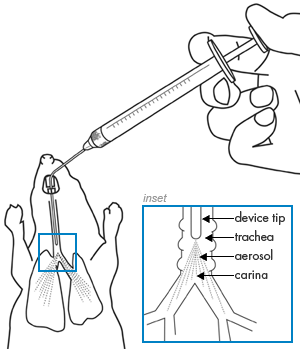
The process of intratracheal administration is essentially a form of intubation. For intrapulmonary applications, the tip of the device is gently inserted down the trachea of the anesthetized animal – near to, but not touching the carina (first bifurcation).
For planning help, see our Instructions for Use of the MicroSprayer® Aerosolizer – MSA-250.

